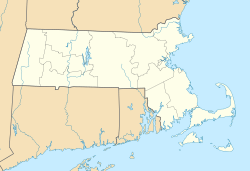Fenway Studios facts for kids
|
Fenway Studios
|
|

The entrance to the building
|
|
| Location | Boston, Massachusetts |
|---|---|
| Built | 1906 |
| Architect | Parker & Thomas |
| NRHP reference No. | 78000473 |
Quick facts for kids Significant dates |
|
| Added to NRHP | September 13, 1978 |
| Designated NHL | August 5, 1998 |
The Fenway Studios are special buildings in Boston, Massachusetts. They are located at 30 Ipswich Street. These studios were built for artists to work in. They became a National Historic Landmark in 1998. This means they are very important to the history of the United States. Fenway Studios is unique because it's the only artist studio building still used for its original purpose. Plus, artists helped design it!
Contents
Why Fenway Studios Was Built
The Fenway Studios were built after a big fire in 1904. This fire destroyed another building called Harcourt Studios. Many artists lost their homes, their studios, and all their artwork in that fire.
After the fire, important business and city leaders decided to help. They quickly bought land and hired architects. Their goal was to build new, safe studios for the artists.
Designing the Perfect Art Studios
The architects, Parker and Thomas, designed Fenway Studios carefully. They made sure every one of the 46 studios had "north light." This type of light is best for artists because it's steady and doesn't change much.
The studios also had very tall windows, about 12 feet high. The ceilings were even taller, at 16 feet. Some studios even had fireplaces. The outside of the building was made with a special kind of brick called clinker brick. It was built in the Arts and Crafts style. Artists were able to move into the new studios in 1905.
Famous Artists Who Worked Here
Many well-known artists and teachers used the studios. They created amazing art inside these walls. Some of these artists include:
- Marion B. Allen
- Lila Perry Cabot
- Joseph Decamp
- Philip Hale
- Lilian Westcott Hale
- Charles Hopkinson
- György Kepes
- George Loftus Noyes
- William Kaula
- Lee Lufkin Kaula
- Lillian and Leslie Prince Thompson
- William Paxton
- Marion L. Pooke
- Edmund Charles Tarbell
- Mary Bradish Titcomb
Fenway Studios in Books
Fenway Studios has also appeared in books! The mystery novel "The Palace Guard" by Charlotte MacLeod features two artists living and working there. A lot of the story happens in and around the studios. Another book by the same author, "The Odd Job," also mentions these characters and the location.
Saving Fenway Studios
By 1974, the studios were not being taken care of very well. The owners owed a lot of money in taxes. A group called "Artists for the Preservation of the Fenway Studios" was formed. Their goal was to save these important buildings.
In 1981, they got a loan to pay the back taxes and make needed repairs. After renovations were finished in 1982, the studios became a special type of cooperative. This means the artists who work there also own a part of the building.
Recent Repairs and Today
In 1998, problems were found with the outside walls of the building. Emergency repairs were needed, which cost a lot of money. More funds had to be raised by a group called the Friends of Fenway Studios. As of 2007, about 25 artists still work in the studios. They create art using many different materials and styles.
Images for kids





